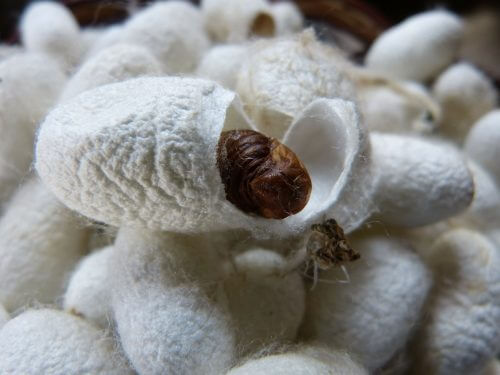The silk capsules are strong enough to protect sensitive molecules, such as antibodies or other proteins. In the future, it may be possible to use capsules in order to send medicines or vaccines to the desired organ in the body, so that they do not disintegrate on the way.

At a rate of 7.5 meters per hour, the silkworm wraps itself in a cocoon, preparing itself for the next stage of its life - a motionless cocoon that will turn into a butterfly within days. The unfolding life cycle of the silkworm has fascinated the imagination of humans for years, but is it also possible to weave scientific research from it? Dr. Uliana Shimanovitz, a new researcher at the Weizmann Institute, and her research partners succeeded in producing tiny silk capsules that simulate the cocoons that envelop the silkworms. These capsules can be used to "transport" sensitive cargo, such as natural silk proteins, antibodies with medical properties, or any other delicate molecule. The study, which Recently published in the scientific journal Nature Communications., may lead to new applications in the pharmaceutical, cosmetic and food industries.
Until now, the use in industry and research of silk proteins, from which silkworms and spiders spin their elastic webs, has been extremely limited, because once these proteins are extracted from the animal, they have a tendency to produce nanofibers that stick together. Instead, it is customary to use chemically processed silk fibers. However, Dr. Shimanovitz, from the Department of Materials and Surfaces at the institute, aims to understand the natural system that prevents silk proteins from sticking to each other inside the gland of the silkworm or spider - and to imitate it. Shimanovitz did this as part of her post-doctoral studies under the guidance of Prof. Thomas Knowles from the University of Cambridge. Researchers from the Universities of Cambridge, Oxford and Sheffield in Great Britain, and from the Zurich Institute of Technology also participated in the study.
Silkworms store their silk proteins in glands when they are in a liquid aggregate state. From this reservoir, the larvae spin their webs to build the protective cocoon, which will allow them to later transform into a butterfly. Dr. Shimanovitz and her colleagues developed a method for the synthesis of tiny capsules that simulate, on a microscopic scale, the process of creating the cocoons in silkworms. To this end, the scientists placed proteins extracted from the larvae in microscopic channels on a chip of polymeric material derived from silicon, causing the protein molecules to assemble themselves within the channels and congeal into a gel-like substance. Microscopic capsules were formed inside the gel, and inside the rest of the protein remained protected in a solution, just like in the silk glands of the larvae. By controlling the degree of viscosity of the solution and the forces acting on it, the scientists were able to control the shape of the capsules - round or cylindrical - and their size, from 300 nanometers to more than 20 microns. The natural silk proteins were kept inside the capsules for an unlimited time without losing their properties and functionality. "Manufacturing capsules from synthetic materials is a complex process that requires a lot of energy. In contrast, the silk capsules are easier to produce, and it requires much less energy. Furthermore, silk is a biodegradable biological material", explains Dr. Shimanovitz.

The silk capsules are strong enough to protect sensitive molecules, such as antibodies or other proteins, and to prevent the loss of desirable properties of these molecules. In the future, it may be possible to use capsules in order to send medicines or vaccines to the desired organ in the body, so that they do not disintegrate on the way. Moreover, Dr. Shimanovitz emphasizes that the tiny capsules can also cross the "blood-brain barrier", thus possibly making it possible to develop with their help new drugs for neurodegenerative diseases, such as Alzheimer's or Parkinson's.
Since the capsules break down in the body, they may also be used in the food industry, for example to infuse bread or other types of food with biological substances that are beneficial to health, such as healthy fats. Other possible applications of natural silk proteins within the new capsules include the development of skin treatments to heal burns, or for use as cosmetics and designing strong elastic fibers for tissue engineering; For example, to create improved biological implants.
In the video: the production of the microscopic capsules as captured by a phantom camera at a speed of 700 thousand photographs per second (© 2017 Knowles Group):

2 תגובות
My dear father, you wrote, by the way, the nature in gematria 86 is the name of the Lord God in gematria 86, the one and no other who knows better than any scientist what is healthy for us and what is not, so please spare yourselves unnecessary effort in trying to prove to yourselves that your mind is developed and let's say yes and you are doing great research, let the food remain natural From the Creator (nature) Thank you
When using medicine for sick people it is excellent.
This is very bad for the food industry.
Dear scientists, you have introduced enough chemicals into our food that are only harmful to our health!
Please stop introducing chemistry, biology and genetic engineering to our food!
Nature knows better than any scientist, what should be in our food.